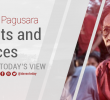The pedagogical precept of Paulo Freire that meaningful learning should be dialogical rather than conducted in the banking method found its concrete realization in my experience with a group of grassroots masa in my neighborhood. Our first session—I call it first game encounter— happened spontaneously. It was without preparation, a learning activity totally unrehearsed.
It happened when I bumped into a group traysikad drivers who were in a middle of their lively conversation in their makeshift shed. Of course, they were all familiar faces and auld acquaintances either as former drinking buddies or basketball playmates. In a very casual and friendly manner, they invited me to join them. And there and then someone threw a provocative question, “Bay Don, who do you think should the people vote for President this coming election?”
Caught off-guard, I threw the question back to them very much like passing the ball to the point guard of a basketball team for him to devise a play stratagem that could bring the ball to the basket. And the question bounced to and fro among the traysikad informal learners. And in an instant I became a facilitator—no, not a teacher, mindful of Paulo Freire’s alternative learning technique, and careful not to apply the banking method.
The “who” was a crucial element in the question. And I dribbled the question on creatively, extemporizing on related and relevant evocative questions as one would pass the basket ball from one player to another. So the who would logically point to a more fundamental “back pass”:“What is the basic problem of our society to be resolved?” And almost everyone recited “poverty”. And the next “back pass” would be “What could be its cause?”
Most of the traysikad learners would of course forthrightly cite corruption as the reason why poverty flourished. And everybody chorused that most, if not all the past and present leaders in government are corrupt and corruptible.
As facilitator I had to make another evocative question, another “back pass” such as “what could be the root cause of corruption?”. . . “what is its origin?”. . . “when did it start or where could it have come from?” . And the question should require their thinking prowess to advance ideas and theorizations.
And the precious word of wisdom would now be posed creatively by the facilitator— a glittering piece of gold from the treasury of wisdom of our ancestors: “Ang dili molingi sa gigikanan dili makadangat sa paga-dulngan!” [He who does not look back to his past would fail to arrive at his destination]
And the evocative question would be passed to another evocative question and so on, stimulating the learners to come up with answers they would be able to mine from their own experience. Soon, the facilitator would provide them the “3-point shot” or the necessary “penetration lay up” that would bring them to facts and events of history. And voila! The historical roots of corruption would be unfolded from colonial times, up to the very doorway of the proclamation of the Philippine Republic.
And the historical truth of puppetry by the very first President, Manuel A Roxas, to the US imperialists would serve as his inaugural address to the Filipino nation. It is his very legacy that every subsequent President adhered to without exception in his/her own administration.
And the fact of the overwhelming control by the US of our economy, politics and culture would score as a new learning—a winning 3-point shot! — that would unmistakably seep into the consciousness of the traysikad learners and open their eyes to a blinding truth.
And the traysikad learners, at the end of the first in a series [an extemporaneous seminar] much like a championship game, did winningly exclaim “Aha! And so there is the culprit!”— namely, that unbridled puppetry of our leaders to US imperialist interests constitutes the watershed of corruption in our social set up, and the historical root cause of the ever-worsening poverty of the majority of the Filipino masses.






